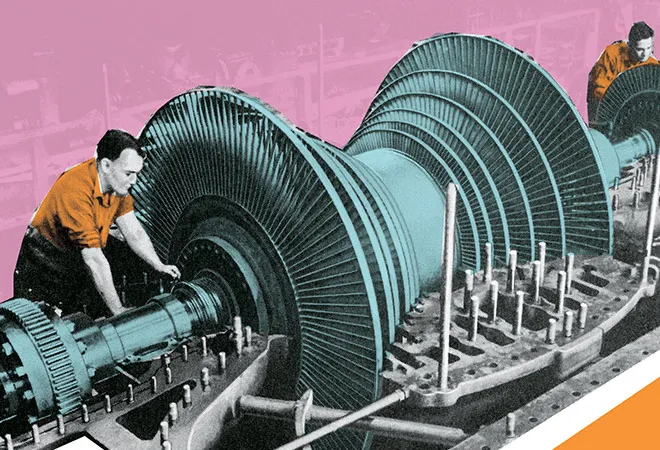
The Indian economy had been ‘going downhill’ even prior to the pandemic. In its recent projections, the IMF has further stated that the Indian economy is expected to contract by 4.5 percent in 2020 due to the disruptions from the cascading lockdowns and bottlenecks in the supply chain. The primary concern for the economy, however, is deeper rooted than the virus. It is the general lack of effective demand across the country. Due to widespread income inequality, which is further aggravated by a majority of the Indian workforce being employed in the informal sector, the section of the population who have a higher willingness to spend have been left with lesser disposable income in their pockets. Some estimates peg the share of informal sector employment in the country at 81 percent. According to the World Inequality Database, between 1988 and 2013 the share of the top 1 percent in India’s pre-tax national income increased from around 10 percent to more than 21 percent, while the share of the bottom 50 percent declined drastically from around 22 percent to 15 percent. Not only has this led to a skewed distribution of income, but also created fractures in the socio-economic and political structure of the country which the pandemic has visibly exposed. Therefore, reviving the economy will require addressing the two major challenges of a rising informal labour force and slackening demand.
Due to widespread income inequality, which is further aggravated by a majority of the Indian workforce being employed in the informal sector, the section of the population who have a higher willingness to spend have been left with lesser disposable income in their pockets.
The two are in fact interlinked with one another. We will explain in due course of the article how improving the wages of workers and providing them with better social security is in the interest of the economy as a whole. During the pandemic, several state governments have suggested suspending several labour laws to boost economic activity. It is based on the notion that current labour regulations are stifling entrepreneurship and impeding economic growth. While it is true that certain regulatory compliances have propagated corruption and added to the costs of transacting business, the proponents of these labour reforms do not downplay the importance of guaranteeing minimum wages, congenial working conditions or health and safety requirements. Nonetheless, this approach fails to address the issue of informal workers. These workers do not fall under the ambit of these labour laws and most of them have been left without jobs in the current situation. As highlighted earlier they also account for a majority of the workforce — and signify the potential loss in aggregate private consumption demand.
Some of these reforms have increased the threshold of the number of workers necessary to fall under the ambit of labour laws. This has essentially informalised the relatively small formal sector employment in India. Is the current trajectory of labour reforms appropriate? On the one hand, some of the reforms are in direct contradiction with the protection of labour rights, while on the other hand, it does nothing to resolve the problem of large-scale informal sector employment in the country.
Is it a path to recovery or further deepening of the crisis?
According to Annual Survey of Industries (ASI) reports, the share of wages in the total input costs has been visibly low (varying between 2-3 % over the years). Hence, a relative weakening of the bargaining strength of workers, which may affect their future wages, cannot be expected to lower the costs of production significantly. Moreover, the labour market in India is already characterised by low wages and considerably less protected compared to its competitors in the region. Yet as companies seek to move out of China, they are looking towards countries like Vietnam and Thailand, which not only have higher wages but also more effective and comprehensive worker protection than India. Reforms leading to reduction in workers’ income and social security affect their ability to demand goods and services, as well as lower their productivity. Apart from generating further inequality between the contending profit-earning and working class, it also leads to a redistribution of income within the profit-earning class itself, tipping the scales in favour of the large businesses as opposed to the smaller ones. This is because small and marginal businesses are more vulnerable to demand shocks.
Reforms leading to reduction in workers’ income and social security affect their ability to demand goods and services, as well as lower their productivity.
Again, a fall in demand can have serious spillover effects on the employment and income opportunities of the workers in the informal sector which may exacerbate the existing demand crisis in the economy. Besides, extractive labour laws can serve to increase the size of the already large informal sector leading to lowering of wages in this sector and also create impacts, often, unfavourably biased towards women workers, who commonly become involved in unpaid labour. Furthermore, a larger informal sector essentially implies that a greater share of workers is eventually deprived of the opportunity to rise up the global value-chains and perpetuates inequality.
Creating a more inclusive labour market
In a 2011 paper, Simon Deakin and Prabirjit Sarkar argued that contrary to the belief that pro-worker labour regulations lead to contraction in output, the empirical results have shown that stronger pro-worker regulations boost employment and increase industrial output. It was based on a study of the industrial sector in India and focused on the formal sector workers. Their results suggest that by formulating labour policies that are more inclusive and bringing the informal workers into its ambit, the problems of declining industrial output and employment can be addressed. For example, Japan and South Korea have emerged as major manufacturing power houses despite a heavily unionised workforce. Such policies have the potential of gradually reducing the unfavourable distribution of income between labour and capital.
Even if the investors respond vigorously to a rising profit share, the economy is presently disrupted by both supply chain disruptions as well as critically low aggregate demand, which would make the realisation of these profits particularly difficult.
If the nature of labour market interventions is such that it effectively leads to a higher wage share or greater formalisation of the workforce, then the aggregate consumption demand in the economy rises. This is based on the Kaleckian argument that the propensity to save out of wages is generally lower than the propensity to save out of profits. In a demand constrained economy characterised by oligopolistic market structure, this increase in aggregate demand is necessarily met by output expansion and a higher degree of capacity utilisation. An increase in effective demand stimulates investment in the economy leading to higher rate of capital accumulation and higher growth in the long run. Although there might be an initial fall in the profit share due to a higher wage share, an increase in the degree of capacity utilisation, investment and growth in the long run actually translates into higher rate of profits earned by the investors. Such a growth path is necessarily “wage-led” and may transcend into what is termed as “cooperative capitalism.” Moreover, even if the investors respond vigorously to a rising profit share, the economy is presently disrupted by both supply chain disruptions as well as critically low aggregate demand, which would make the realisation of these profits particularly difficult. Therefore, a “profit-led” growth trajectory pursued through labour reforms that reduce the bargaining power of workers may not yield the desired results.
Labour market reforms need to address the issue of both quantitative as well as qualitative mismatches. Some of the existing laws do make it difficult to hire and fire workers in industries with total number of workers above a particular limit, and thus restrict the size of firms and their ability to harness the potential of economies of scale. This can be circumvented through government interventions and the creation of a labour market with records of the skill level and current status of employment which may facilitate ease of education-to-work, unemployment-to-work and job-to-job transitions; increase workforce participation and promote skill-based hiring. The government can intervene to re-train those laid off, and help them find new suitable jobs, in addition, to providing an unemployment relief during this period. But all these require the presence of a formal market with proper employment records. The National Skill Development Corporation of India can be roped in to create a platform where workers across sectors can register and help in the maintenance of a database. Private players could be urged to be a partner in this process by giving them additional tax benefits. Some of the problems between trade unions and producers could also be avoided through this if the workers are assured of an unemployment relief and adequate opportunities to re-skill themselves in accordance with industry standards.
The government can intervene to re-train those laid off, and help them find new suitable jobs, in addition, to providing an unemployment relief during this period. But all these require the presence of a formal market with proper employment records.
While this may already be present in some form for those engaged in the formal sector, the informal sector with its substantial size is in urgent need of such a platform. More recently, the Parliamentary standing committee on labour incorporated a ‘contributory social security fund’ for the unorganised sector in its code on social security. This is a welcome development and if adopted would incentivise workers in the unorganised sector to register themselves. Labour reforms along these lines will lead to a reduction in income inequality by gradually increasing the share of wage in national income and subsequently boost aggregate demand in the economy in a more sustained manner.
The views expressed above belong to the author(s). ORF research and analyses now available on Telegram! Click here to access our curated content — blogs, longforms and interviews.




 PREV
PREV



